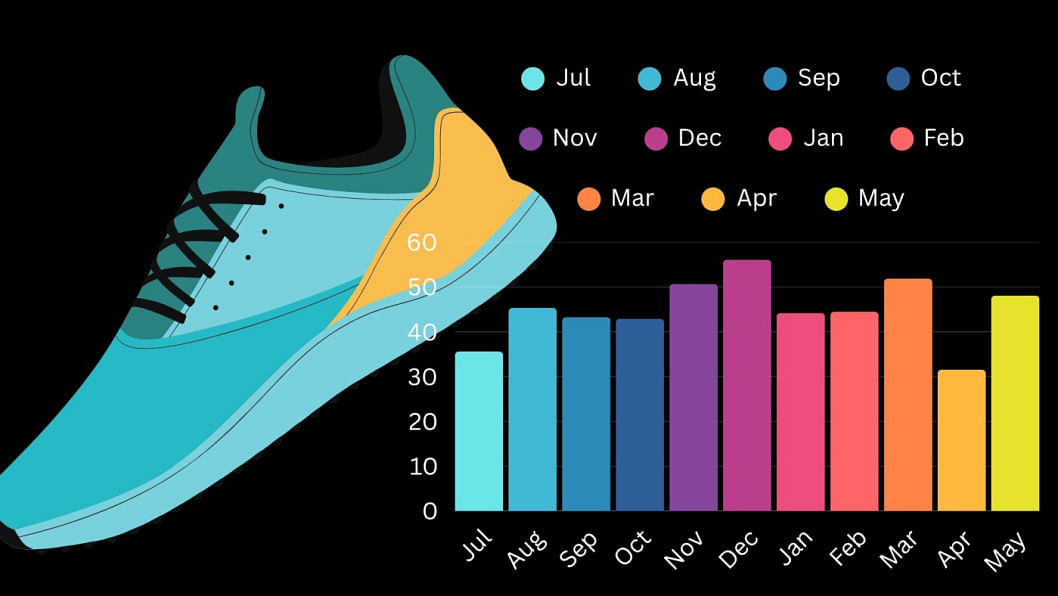Synthetic footwear exports soar as global demand shifts

Bangladesh's non-leather footwear sector is emerging as a steering force in the country's export landscape, driven by global shifts in consumer preferences, strong manufacturing capacity, and competitive pricing
While leather footwear still leads with $620.17 million in exports until May of fiscal year 2024-25, up 28.96 percent year-on-year, the non-leather segment is rapidly catching up.
In the first 11 months of the current fiscal year, non-leather footwear exports fetched $494.28 million, marking a 30.25 percent growth compared to $379.48 million in the same period of the previous fiscal year, according to Export Promotion Bureau data.
In May alone, leather footwear fetched $74.82 million compared to $48.37 million a year earlier.
Industry insiders credit this growth to modern production capacity and fewer compliance burdens, making it easier for Bangladeshi manufacturers to meet global standards and attract international buyers.
"The non-leather segment benefits from fewer regulatory hurdles," noted one industry expert.
"Unlike the leather sector, which requires certification from the Leather Working Group (LWG) and faces challenges related to raw material quality and environmental compliance, synthetic footwear producers primarily need to meet factory compliance standards," he said.
As demand for fashionable, affordable, and sustainable footwear grows globally, particularly among younger consumers, the synthetic footwear segment is well-positioned to become a key contributor to Bangladesh's export diversification strategy.
In the decade preceding the end of FY24, non-leather footwear exports ballooned 120 percent, jumping from $189 million to $416 million.
"The young generation in the Western world is shifting from leather to synthetic shoes as they are more comfortable, fashionable, and cheaper," said Riad Mahmud, managing director of Shoeniverse Footwear.
In contrast, leather shoes are worn for formal occasions and have limited design flexibility, causing a global demand decline of around 12 percent annually, he noted.
This shift has fuelled steady growth in synthetic shoe demand over the past five to six years.
Shoeniverse's Mymensingh-based factory, employing around 4,700 workers, supplies footwear to major global brands including Inditex, Aldi, Matalan, and RedTape.
Mahmud said global brands are increasingly placing orders in Bangladesh, drawn by its competitive labour costs and proven expertise in apparel manufacturing.
He emphasised that the non-leather footwear sector holds strong potential due to its labour-intensive nature, giving Bangladesh a cost advantage over countries like Vietnam.
However, challenges persist. Delays in customs clearance for raw materials hamper lead times—a critical factor in the fashion-driven synthetic shoe market that demands quick delivery.
Despite this, demand remains robust. Shoeniverse is fully booked through March next year, with buyers seeking new slots amid potential US tariffs on Chinese goods.
A market assessment by Bangladesh Investment Development Authority (Bida) supports the trend, citing rising non-leather footwear exports due to increased orders from global brands such as H&M, Puma, Decathlon, FILA, and Kappa.
Major export destinations include Spain, France, the Netherlands, South Korea, India, Italy, and Germany.
Maf Shoes Ltd, a TK Group subsidiary exporting to France and Germany, boosted daily output from 50,000 to over 65,000 pairs. "European demand is soaring but structural barriers remain," said Managing Director Hasnat Md Abu Obida Marshall.
Europe remains the top market for Bangladeshi synthetic shoes, yet exporters face customs confusion, weak logistics, and exclusion from RMG-specific waivers.
"During Eid, our containers were stuck, but penalty waivers applied only to the BGMEA," a frustrated exporter said.
Moreover, competing with China is tough. While Chinese exporters enjoy 7 percent to 12 percent incentives and raw material self-sufficiency, Bangladesh battles high import duties, delays, and little policy support.
"We import everything and still try to compete on price," said one exporter.
The country also lags in value-added footwear. Despite paying lower wages than Vietnam, productivity remains much lower in Bangladesh.
"We are burning money just to keep factories running," the exporter added.
Some big global firms are eyeing India for relocation, drawn by availability of land, tax breaks, and better infrastructure in states like Tamil Nadu and Kerala.
"India calls investors—we don't even have an exit policy for foreign investment," said Marshall.
To unlock growth, exporters are calling for swift government action, including a dedicated synthetic footwear policy, equal customs treatment as RMG, access to technology financing, and incentives for backward linkage industries, he said.
Jakaria Shahid, managing director of Edison Footwear Limited, sees the synthetic footwear sector as a crucial driver for future export diversification, thanks to its fast-paced expansion.
However, he pointed out that major international brands like Nike and Adidas have yet to enter the Bangladeshi market, mainly because local manufacturers struggle to meet required lead times.

 For all latest news, follow The Daily Star's Google News channel.
For all latest news, follow The Daily Star's Google News channel. 



Comments